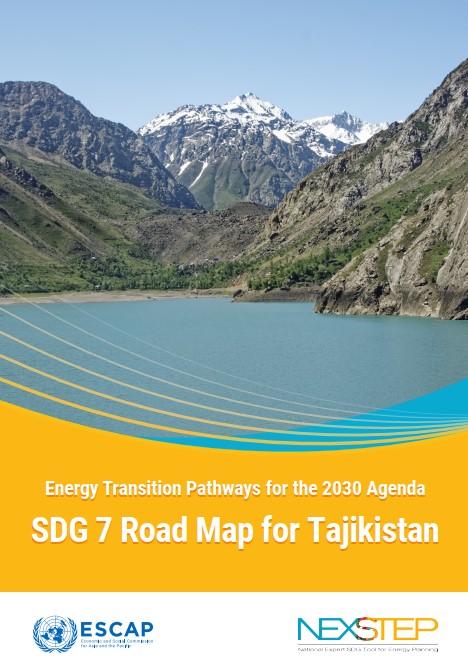Transitioning the energy sector toward sustainability and renewables is essential for achieving the 2030 Agenda for Sustainable Development and the objectives of the Paris Agreement. Such a transition needs to ensure sustained economic growth, respond to the increasing demand for energy, reduce emissions, and consider and capitalize on the interlinkages between SDG 7 (Affordable and Clean Energy) and the other SDGs, thereby presenting a complex and difficult task for policymakers. To address this challenge, ESCAP has developed the National Expert SDG Tool for Energy Planning (NEXSTEP).[1] This tool enables policymakers to make informed policy decisions to support the achievement of the SDG 7 targets as well as those of the Nationally Determined Contributions (NDCs). The initiative has been undertaken in response to the Ministerial Declaration of the Second Asian and Pacific Energy Forum (held in April 2018, in Bangkok), and the Commission Resolution 74/9, which endorsed its outcome. NEXSTEP also garnered the support of the Committee on Energy in its second session, with recommendations to expand the number of countries being supported by this tool.
This SDG 7 Road Map was developed in collaboration with the Tajikistan’s Ministry of Energy and Water Resources (MEWR) and national stakeholders. It evaluates whether existing national policies are sufficient to meet energy access, renewable energy, and energy efficiency targets. The Road Map introduces three key scenarios—Business-as-Usual (BAU), Current Policy Scenario (CPS), and SDG Scenario—alongside ambitious long-term pathways toward Carbon Neutrality and Net Zero by 2050. These scenarios provide Tajikistan policymakers with robust options for navigating a sustainable energy transition aligned with national priorities and global climate commitments.
[1] The NEXSTEP tool has been specially designed to perform analyses of the energy sector in the context of SDG 7 and NDC, with the aim that the output will provide a set of policy recommendations to achieve the SDG 7 and NDC targets.

Tajikistan has achieved near-universal access to electricity – in 2022, 99.3 per cent of its population had access to electricity. However, access to clean cooking technologies remains a major gap—with only 16.2 per cent of the population, corresponding to 252,888 households, still relied on unclean and polluting cooking solutions. LPG stoves were the most dominant primary clean cooking technology, with an estimated 45.3 per cent share. This was followed by electric cook stoves, which were estimated at 38.5 per cent. The SDG scenario closes this gap by 2030, prioritizing electric cooking stoves as a clean, cost-effective solution, particularly feasible as most (87.5 per cent) of country’s electricity is from hydropower.
Tajikistan’s share of modern renewable energy (excluding traditional biomass) in total final energy consumption (TFEC) was 27.8 per cent in 2022. In the SDG scenario, this rises to 35.1 per cent by 2030, driven by expanded hydropower and the integration of solar and wind resources, especially valuable in winter months when hydro capacity declines. The country’s energy intensity stood at 4.7 MJ/USD2017 in 2022. Under the SDG scenario, this is expected to fall to 3.2 MJ/USD2017 by 2030 — consistent with the global target for energy efficiency. Achieving this will require scaling up efficient appliances, heating technologies, building retrofits, and modernized industrial processes. GHG emissions from the energy sector are projected to remain well within Tajikistan’s NDC commitments. From a 1990 baseline of 21.2 MtCO₂-e, emissions will fall to 8.2 MtCO₂-e by 2030 under the SDG scenario—a 61.3 per cent reduction, surpassing both the 30–40 per cent reduction target of the updated NDC.
Universal Access to Electricity
Tajikistan is on track to reach 100 per cent electricity access by 2024. The challenge now lies in improving supply reliability, particularly in rural and mountainous areas. Where grid extension is not feasible, off-grid and mini-grid solutions offer cost-effective alternatives.
Universal Access to Clean Cooking Technology
Access to clean cooking solutions is expected to reach 100 per cent by 2030 under the SDG scenario. Transitioning to electric cooking stoves, supported by Tajikistan’s hydropower-based electricity grid, is identified as the optimal strategy. This transition also reduces indoor air pollution and health risks, especially among women and children.
Renewable Energy
Tajikistan’s renewable energy share is projected to grow significantly in the SDG scenario—reaching 35.1 per cent of TFEC by 2030 (excluding traditional biomass). While hydropower remains dominant, diversification through solar and wind is essential for energy resilience and winter supply stability.
Energy Efficiency
The energy intensity target under SDG 7.3 is to reach 3.2 MJ/USD2017 by 2030. Under CPS, this figure is projected to be 3.8 MJ/USD2017, while the SDG scenario achieves the global target by expanding measures such as:
LED lighting and energy-efficient appliances
Clean heating (e.g., high-efficiency stoves and heat pumps)
Deep retrofitting of commercial buildings
Motor replacements and digitalization in industries
Nationally Determined Contributions (NDCs)
Tajikistan’s updated NDC pledges a 30 to 40 per cent emissions reduction below 1990 levels by 2030. Under the SDG scenario, total emissions fall to 8.2 MtCO₂-e, exceeding both targets. This is primarily achieved through efficiency improvements and increased renewable deployment.
To accelerate progress toward SDG 7 and the NDC targets, the Road Map proposes the following four policy pillars:
Expand Clean Cooking Access: Promote electric cooking as the national solution, particularly targeting rural and low-income populations. Leverage financing schemes, subsidies, and awareness campaigns to overcome adoption barriers.
Boost Energy Efficiency Across Sectors: Enforce building energy codes, adopt minimum energy performance standards (MEPS), and provide incentives for efficient technologies. Public sector buildings should lead by example through retrofits and energy audits.
Enable Fuel Switching and Electrification: Prioritize electrification of space heating, transportation, and industrial processes. Develop electric vehicle charging infrastructure and expand solar thermal and district heating solutions.
Decarbonize the Power Sector: Scale up investments in hydropower and solar. Strengthen grid integration, storage capacity, and regional interconnections (e.g., CASA-1000). Avoid future investments in fossil fuel-based power generation to prevent carbon lock-in.
